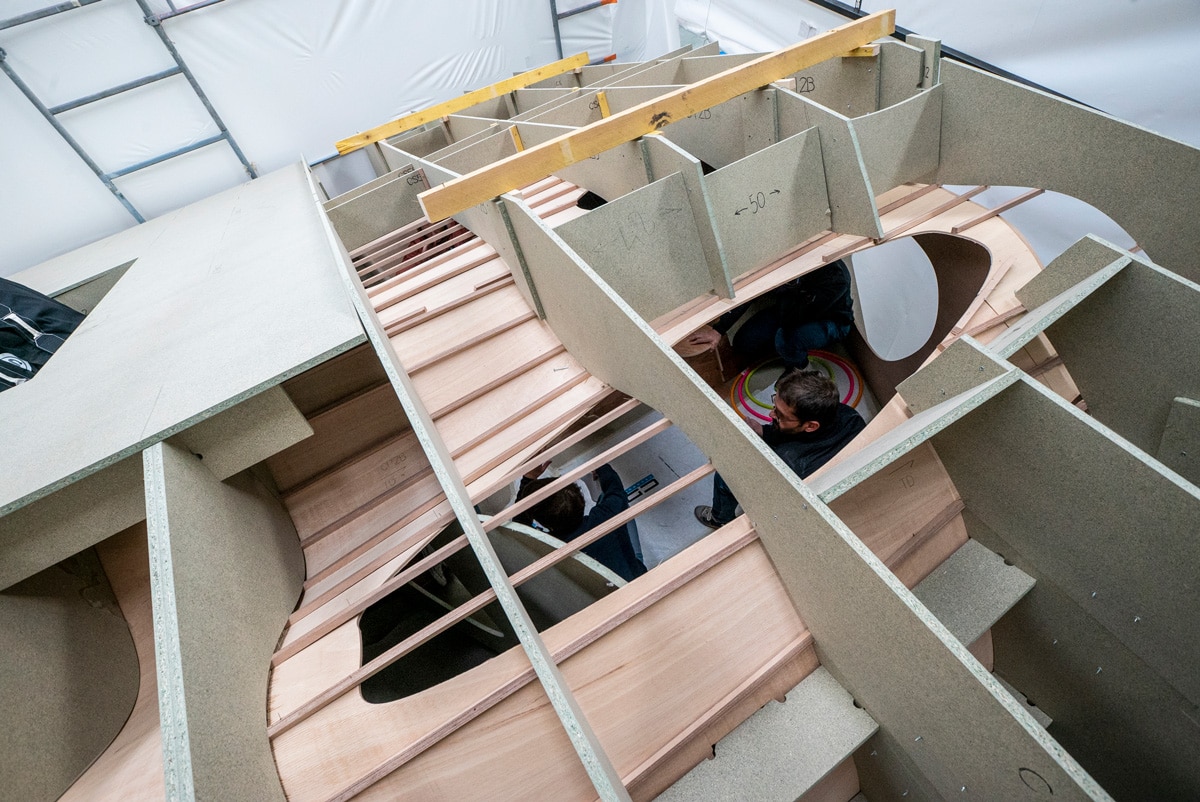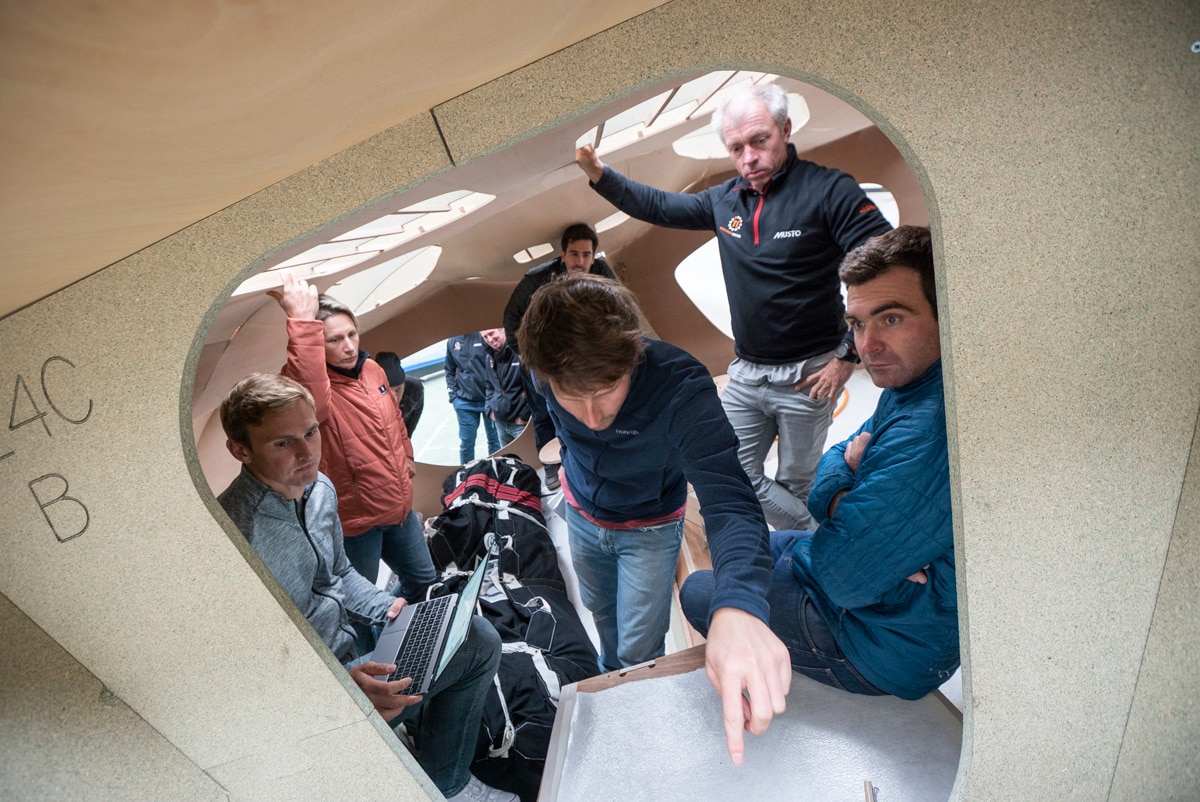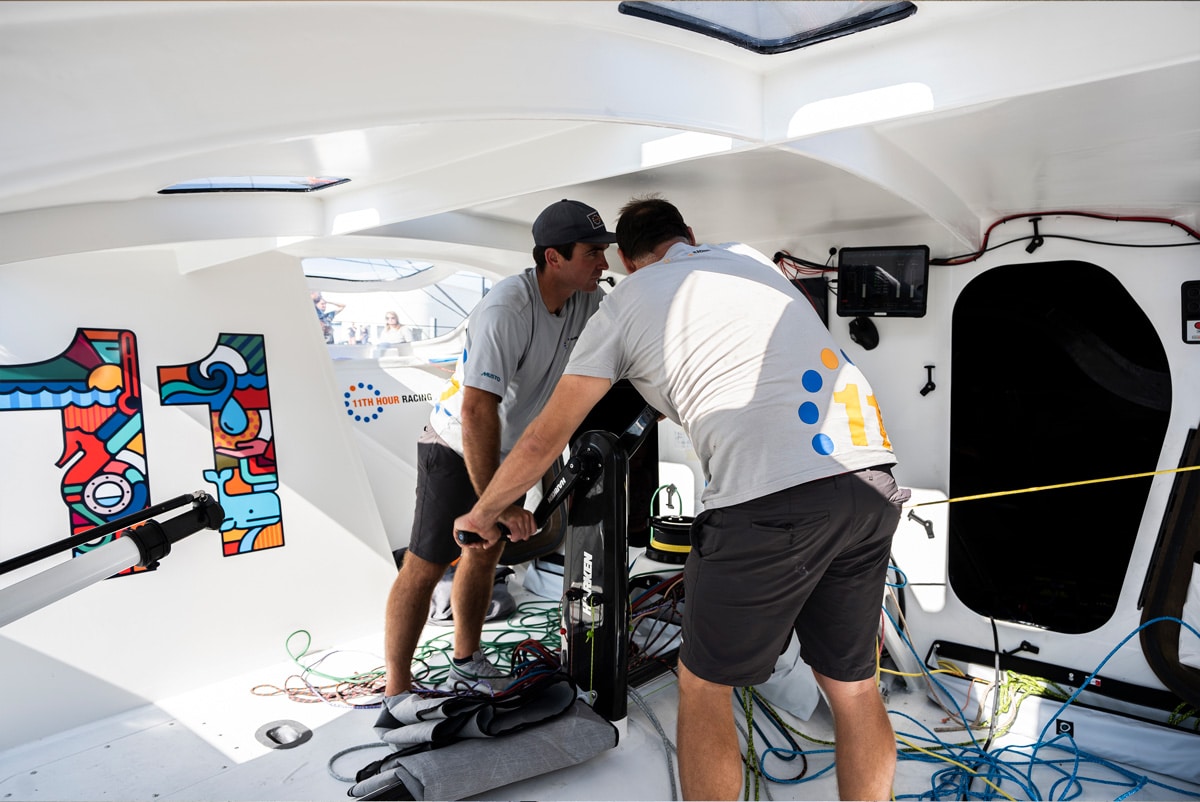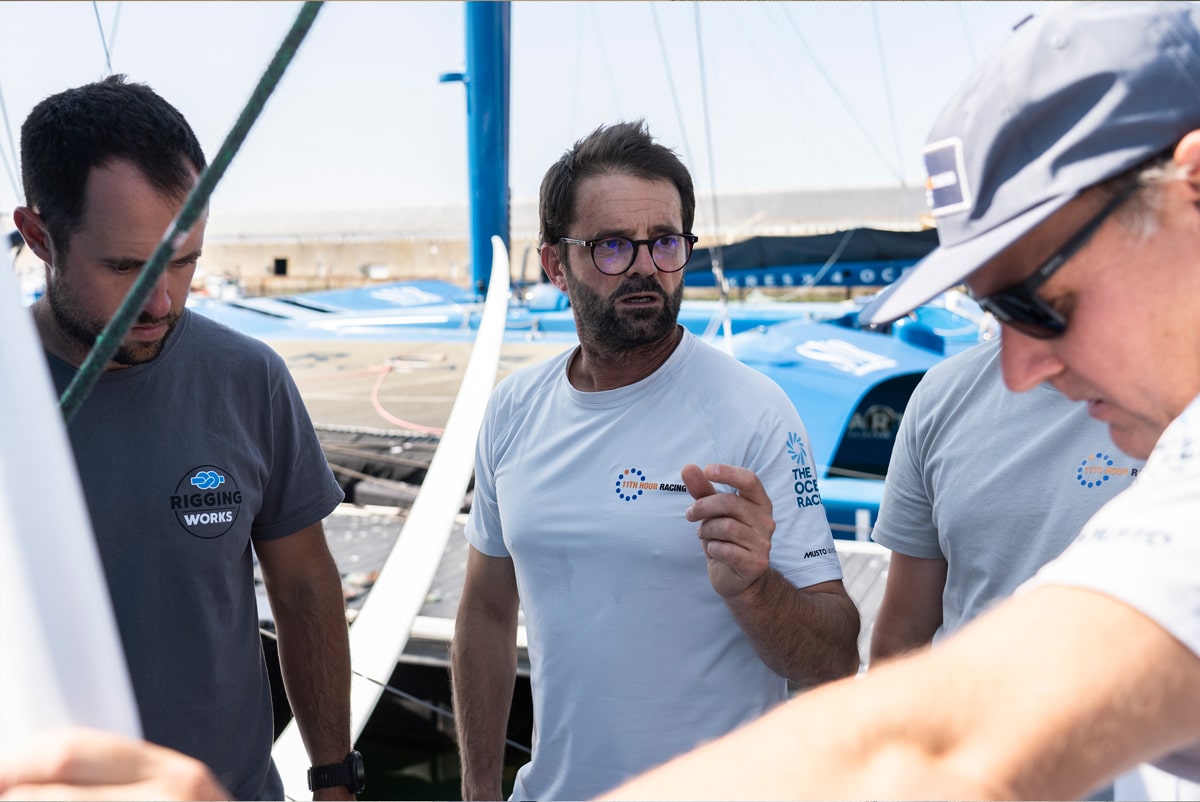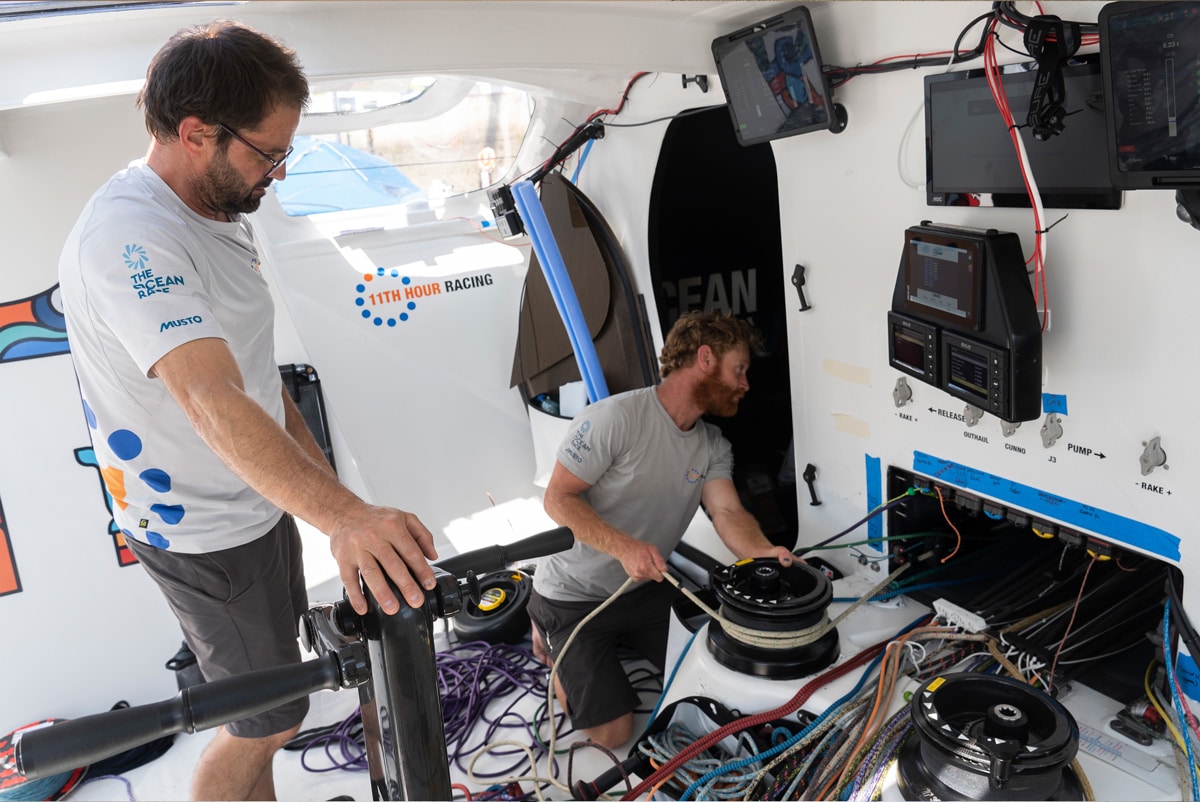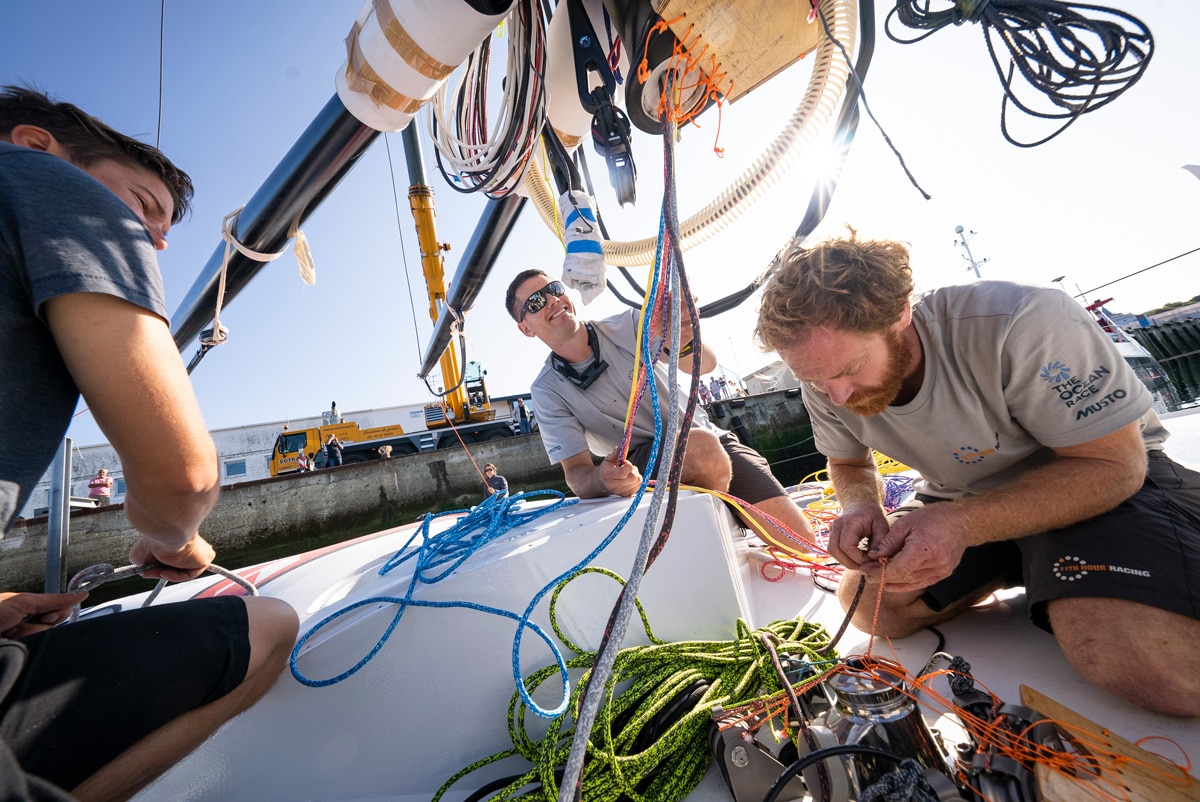Building IMOCA 60 11.2 Part 2: The Design Solutions
Guest author Mark Chisnell provides a three-part series diving into the details of our new IMOCA 60 11.2. In part one, he explores the multiple challenges our team faced when building the boat.
In the second of the series, he digs deeper into the design solutions on the first IMOCA 60 designed for crewed sailing in The Ocean Race.
“The marine environment is harsher than any other, even outer space; the salt, wind, sun, and incredible force of water work to corrode, break down, or tear apart everything onboard. It’s the reason why the marine industry is always chasing stronger and lighter materials and construction techniques. This has led to some very unsustainable solutions, and we must now start to rethink them. We have a design opportunity to make better design choices, choices that could echo or ripple out through other industries. This is a remarkable milestone as we work to change the narrative around sustainability in the marine and maritime industries,” Jeremy Pochman told me, the co-founder and CEO of 11th Hour Racing.
Jeremy Pochman was talking about the launch of the brand new IMOCA 60 designed and built for 11th Hour Racing Team. Taking the lead for many of those choices were Charlie Enright on behalf of the sailing team and the naval architect, Guillaume Verdier. In this, the second of three articles, we’re going to look at the choices the Team made as they worked to optimise the boat’s performance. While in the third story in the series we will look at the approach the team took to its construction, and in particular, building the boat, and managing the team’s operations, as sustainably as possible.
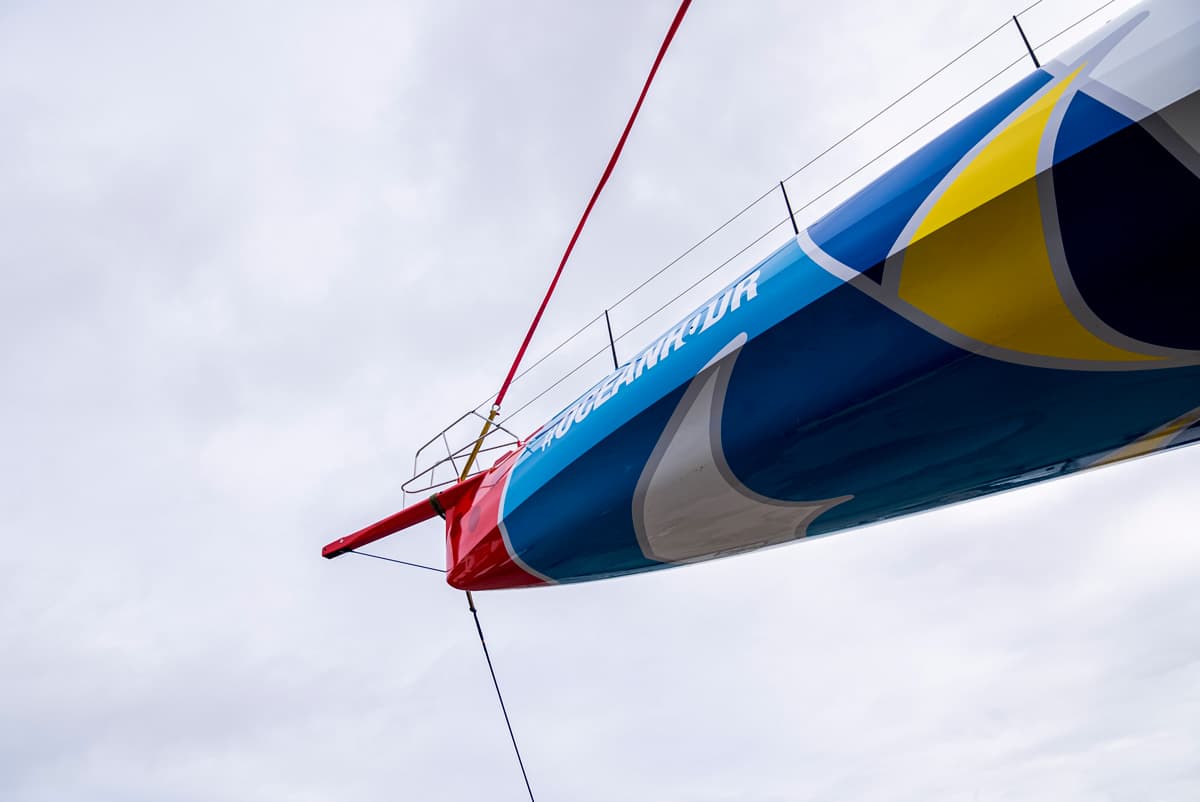
The 2-for-1 hull shape
What better place to start than the hull shape. Charlie Enright explained the priorities for the design of the new boat. “In our experience, in The Ocean Race a lot of the leg starts and finishes are upwind, not something that Vendée Globe sailors typically experience. So we really tried to make an all-around boat with no weaknesses, and once we felt like we had that we tried to enhance its ability to VMG [Velocity Made Good] downwind, basically, without taking away or detracting from the overall objective of an all-rounder.”
“One of the priorities – and we learnt it a little bit with 11.1 [the team’s first boat, the 2016 Hugo Boss] – is to be able to quickly get on the foil,” said Verdier. “The quicker you go on the foil, the quicker you lift a big portion of the weight of the boat. So you want a lot of heave [vertical] stability, so that has been quite a priority. The other priority was really just the safety of the boat. There is going to be a lot of water on the deck and you don’t want to put people at risk so I think that would be the ultimate priority.” The result? “The bow shape section – the section and not the profile view – are quite different from anything you’ve seen before,” said Verdier.
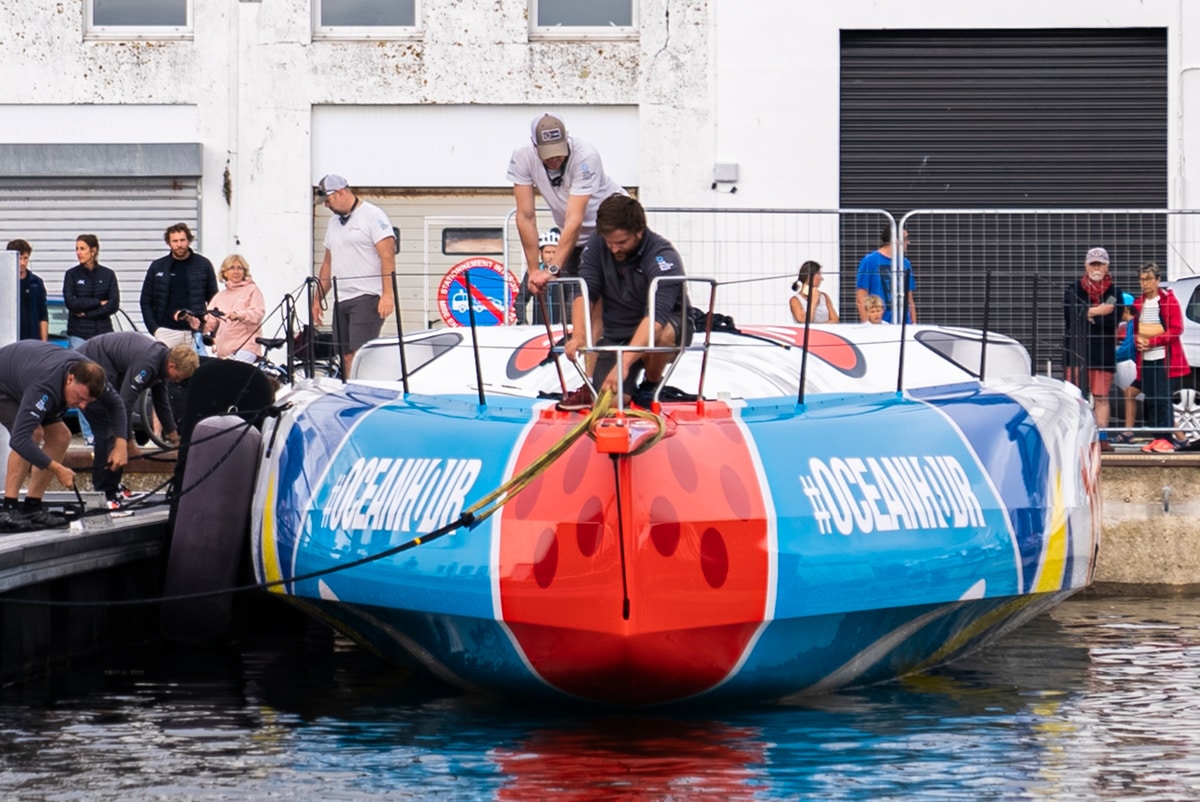
The bow – along with the aerodynamic look of the hull shape – is one of the more striking elements when you first see the boat. “The hull shape itself is an evolution, I would say, of previous Guillaume designs, but with a lot more flair in the bow…” commented Enright. “We didn’t really want to give up too much waterline because we are trying to make an all-around boat. One of the big things is VMG running, keeping the bow up and out of the water. So we have these splashes in the bow that are very, very pronounced, and when the boat’s just sitting there on its waterline, it’s skinny in the front, but the second the bow submerges [if it does], the shape gets really beamy and protective [adding buoyancy quickly], keeping the water off the deck and trying to keep the bow nice and buoyant.”
“When you design boats, it’s always a two-in-one,” explained Verdier. “You always try to design a boat that is okay in light [winds] and during the transition [to foiling]. A boat that has a high righting moment when reaching and is very stable downwind; one that is not going to put the bow down in a wave trough or roll over every time you have a gust or a Southern Ocean squall… you need to have a very resilient boat in a gust.”
Foils full of tricks
The other big development area that the team had to get right to achieve these goals and create a resilient boat are the foils, the design of which is inextricably linked to the design of the hull. “You can make foils that ventilate [air being sucked onto the surface of the foil reducing lift], for example,” said Verdier, “so people always say, ‘Oh, look at the ventilation’ but ventilation is a smart way to self-regulate… It’s a damper. You can have foils that twist under the load, there’s plenty of tricks to play… we have made safe choices in order to avoid burying the nose… And you have to have a boat that if you have no foil is still really safe and really fast. I’d say good luck to the guys that take the option to make a boat that is actually useless once they break the foils or once they have an issue with the foils.”
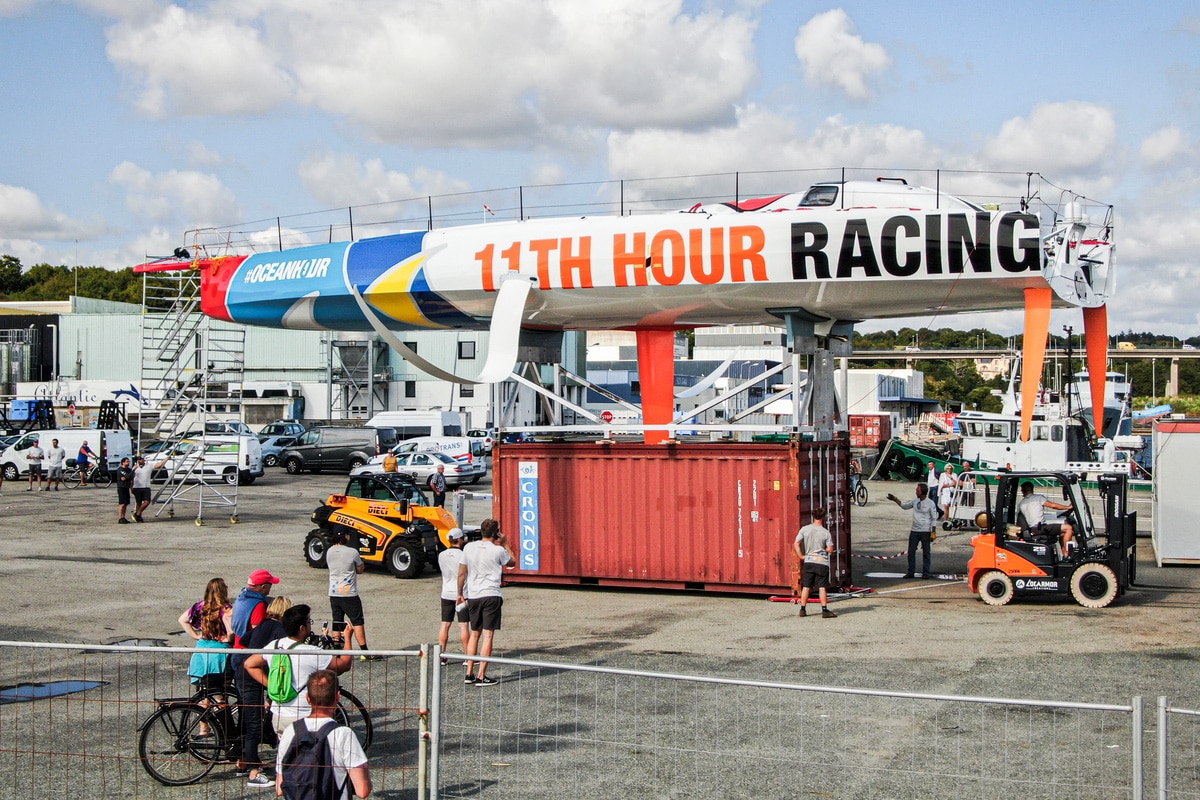
The foils can be controlled in one of two ways, the rake can be changed through five degrees of rotation, and they can be extended in and out of the boat. “The way we made the foil shape is that when we extend the foil, we have different righting moments, and different stability,” said Verdier – so both extension and rake will change the performance of the foils. Verdier was clear on their innovative direction. “The foil shape is very different from what we’ve seen before.”
Enright was also clear on the impact the foils were going to have:
“When you see them roll out of the shed, they’re not really an evolution of what’s already out there. They’re definitely a revolution. We’ve had four different foils, not sets, but different foils on the boat [11.1] since we purchased it in 2019. They have allowed us to improve our construction method, the stiffness, the profile, the section shape: everything that goes into them.”
The aero package
If the hull and foils have been a powerful focus, then the aero package – sails, rig and aerodynamic treatment of the deck – has not been sidelined. “The aero package is not to be underestimated and we’ve invested a lot on it,” said Enright – something that’s clear from the boat’s aerodynamic look. “We did a lot of work on the aerodynamics of the hull itself… all our furlers are flush-deck, all the headsails will be perfectly endplated. We have a big aero fairing on the bow that encompasses the base of the mast and hides a lot of the halyards and deck spreader terminations. It’s made of foam, which also helps with instability in the 180-degree righting test which has an effect on our bulb weight.” It’s not just the headsails either, when I asked Guillaume Verdier what would strike the casual observer as new and different, one of the things he said was, “The fact that the mainsail can be sealed [against the deck].” The whole sail plan will be endplated for greater efficiency.
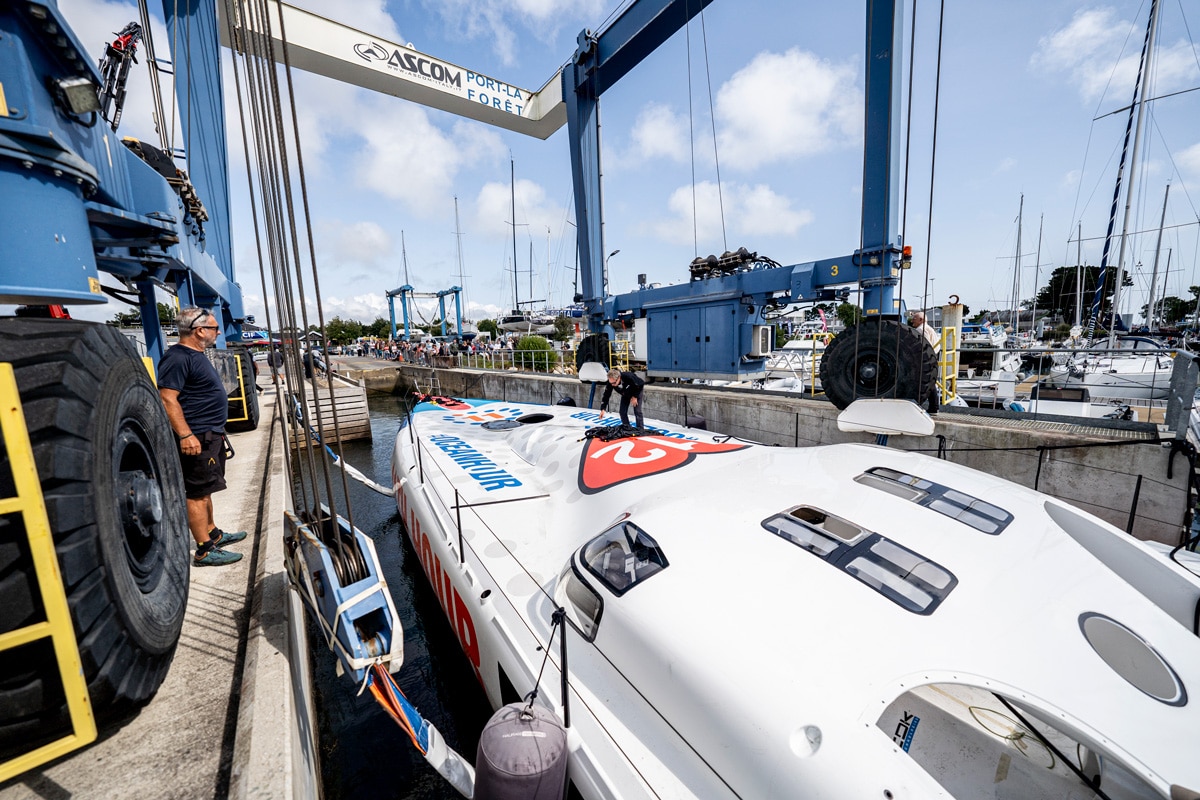
A great deal of work has also gone into the sail inventory, not just the sail designs and crossovers, but also the constructions. “We’re making sails that are probably lighter than any offshore sails that have been built to date, but still fit for purpose. Any issues arise not from the loads, nor the modulus [lack of strength], it’s the continuous sail handling repetition that breaks down the strength,” said Enright.
The control systems for the sails have also been a focus. “Another priority for me is that we can easily tune the sails,” commented Guillaume Verdier. “What you want for these boats is the ability to be accurate when you trim. You want to have fast trimming; you want to make sure that the sailors are super strong so they are not going to slow down. You need more information and feedback to do that. You need more strain gauges and you need more hydraulics for responsiveness and things to move quite fast.”
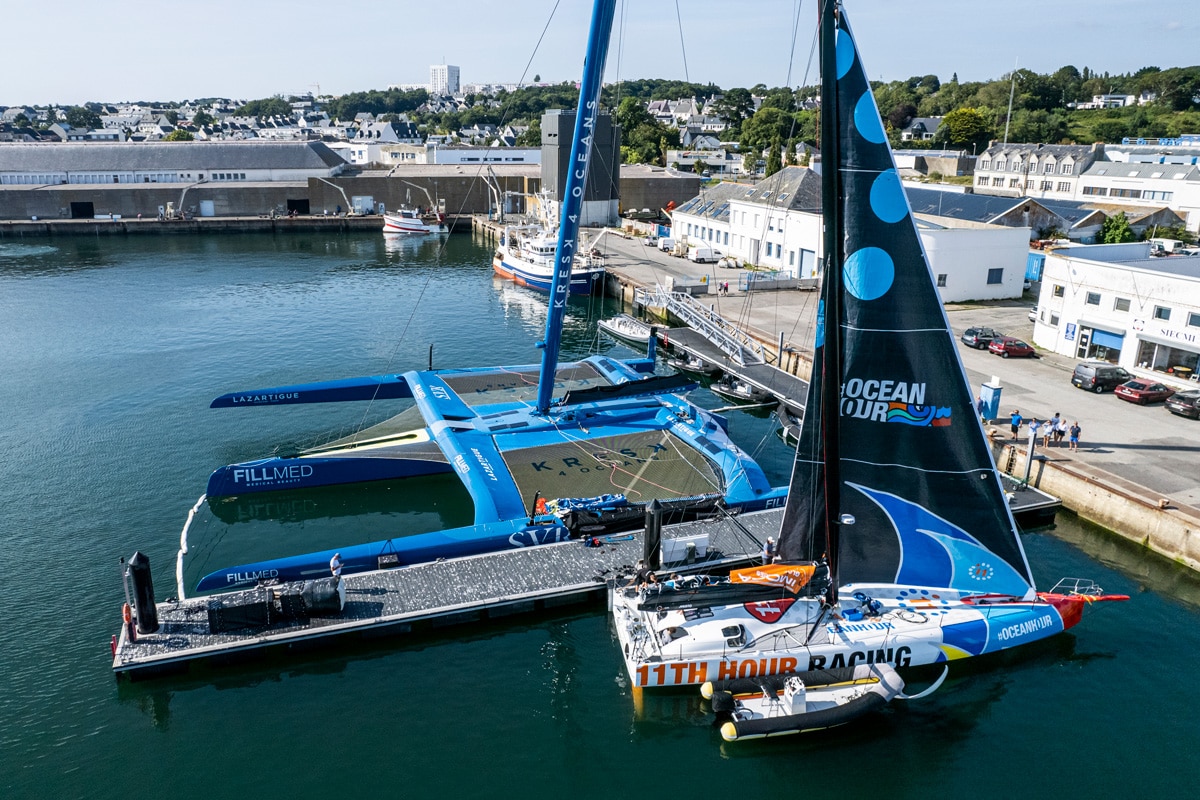
A change in the rules has worked to the team’s advantage in this respect, as Enright explained. “We have a lot more hydraulics on the boat than traditional IMOCAs do… Once they opened up the rake in the boards [to allow movement] you needed to carry hydraulic oil to make that happen, so the marginal weight-cost to add other hydraulics throughout the boat came down astronomically. So you already had the pump, you already had the reservoir and the oil, so to throw an 800 gram Cunningham ram on or something like that, it became a no-brainer in some areas.”
There are other elements that will see a change in style from the traditional IMOCA culture. The team’s Build Manager, and the man responsible for coordinating between all the contractors and the team for the new boat is Wade Morgan, a sailor with three America’s Cups and a Volvo Ocean Race on his CV.
“In terms of our trimming style, we’ve got jib tracks and a straight traveler for the mainsail, so we’re more of an ‘angle of attack’ style of sailing rather than a ‘twist’ style of sailing, which is how a lot of the French guys do it, so that’s a real difference with this boat. We’ve got huge visibility forward and [all] around for the trimming to exploit the fully-crewed nature [of the boat]. We’re not ‘set-and-forget’ because we have the manpower onboard to trim a lot more. So the ergonomics of the trim and then the visibility out to our sail-plan have been key decisions for us.”
Systems and handling
The other aspect of trim onboard a short-handed boat is the autopilot. The Ocean Race originally looked to a rule that would only allow heading-only pilots, and the cockpit was originally designed to allow hand-steering. Now there’s to be a more sophisticated one-design autopilot supplied for The Ocean Race.
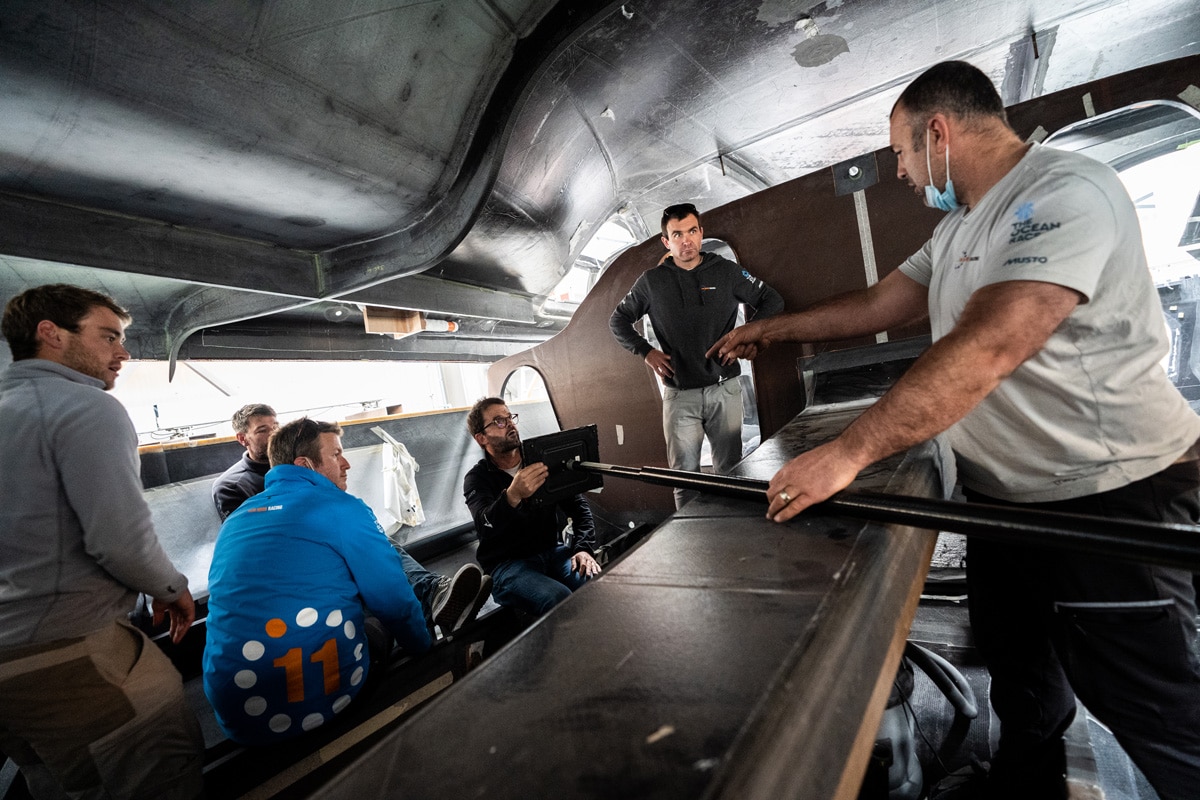
“Autopilot design has come a long way, and in addition there are so many contributing factors to improving performance, from software to better measure our structures and systems, to hardware development in areas like the compass and other advanced sensors,” said Charlie Enright.
”The fact that hand-steering will probably no longer be necessary doesn’t really matter according to Wade Morgan. “Our view has always been to use our on-deck systems and design them in such a way to exploit the extra people onboard to trim harder. If the autopilot comes in, which it has done, then that’s no problem. We’re still going to have the same ability to trim well and make our boat go quicker with the autopilot. So it’s like an extra set of hands, I guess, but it won’t really affect anything we do too much. We’ll be setting the boat up for that style of sailing and probably that’s more what the crew’s used to from the tradition of our Ocean Race standard.”
One of the most striking visual aspects of the newly launched boat, and a departure from what has gone before, is the wide, low profile, covered cockpit with its big windows. It was, along with the interior layout, the result of a long and intensive process that started with a blank page.
“The boats are typically single-handed, short-handed machines, and we were just trying to figure out where to fit everyone. The Ocean Race crew-configuration rule means we have to fit multiple people on the boat. While the IMOCA 60 Class rule incentivizes low freeboard and maximum water ballast, where are the people going to go? Where are the food and spares going to go? How’s everyone going to sleep? Eat? It’s hard. And being able to start from scratch with the new boat on some of those ideas has been helpful,” explained Charlie Enright.
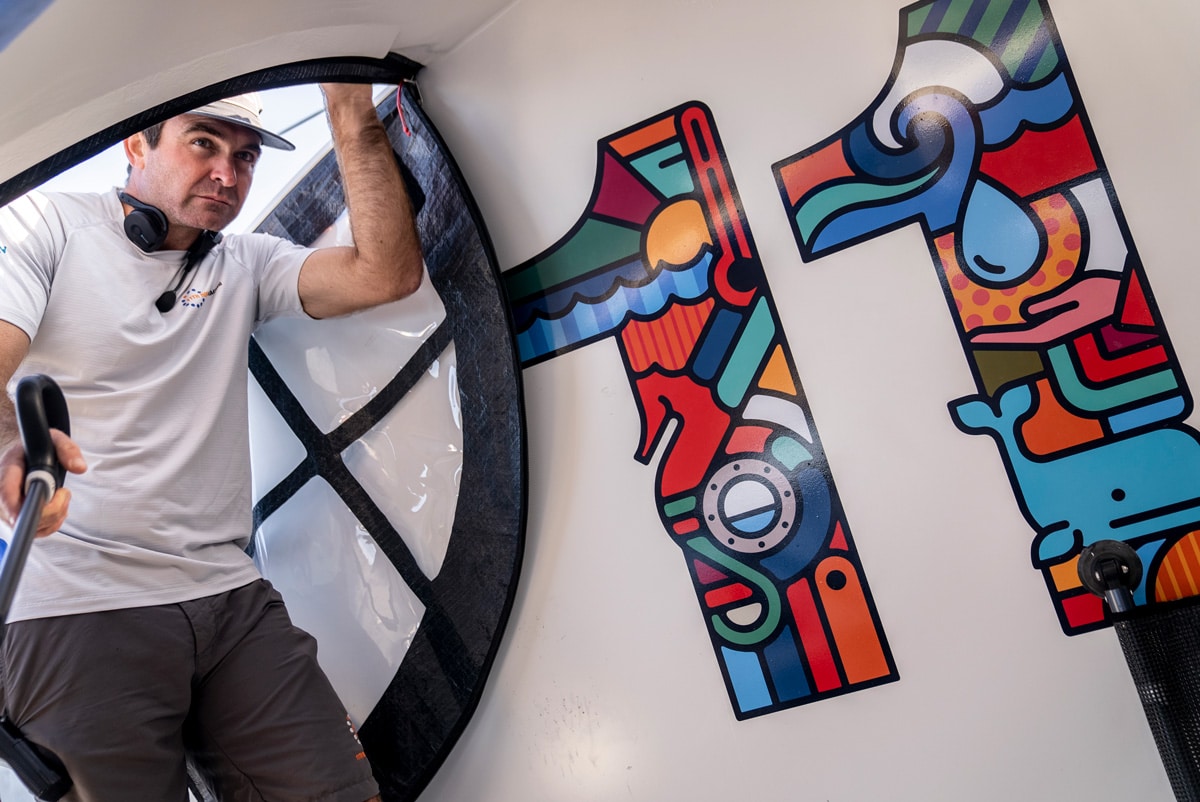
The IMOCA mock-up
The use of full-size mock-ups substantially helped with this aspect of the design. “The mock-up process was intensive,” continued Enright. “It helped with the ergonomics of crewed sailing, where all the people were going to fit, how were we going to do maneuvers, where things were going to lead, where wheels would go, potentially tillers would go, pedestals would go, winches… There were center tunnels, two tunnels, a split pit, left and right, fore and aft. So all these different permutations got addressed one way or another in the mock-up process. And then down below, where are the bunks going to fit? The whole IMOCA rule is governed by the 110- and the 180-degree righting test, so where, volumetrically, can you fit things for as little cost as possible? And when you have to create more volume, what does that mean for the bulb weight and everything else?
“There are an infinite number of loops that can get run on this rule. It is well known how complex it is. It’s not a mystery when you see boats so radically different, because once you change something, the knock-on effect of that one change takes you so far from where you’ve been, and potentially where you were trying to go… We have a whole playbook that we drafted from spending days in the mock-up. It’s different. You used to have a bow man, a mid-bow man, a pit man, a mast man. Now we just have position one through five, and you rotate around as space allows. Whatever winch you’re closest to in a particular maneuver, that’s your job. You don’t have a label. There’s not enough space.”
The mock-up was a potential hit to the boat’s carbon footprint, but some careful planning in advance took care of that. “The deck mock-up was built with FSC certified woods and was fitted together in an almost jigsaw-like way. So without any adhesives or too much metal work,” explained Amy Munro, the team’s Sustainability Officer. “So, you could actually just unclip it all at the end. And then the panels were used for container set-ups and fit-outs and some of the boat builders from CDK even took them home for shelving! The wood at the end of it was of high enough quality that it could have a nice reuse application. So, designing for disassembly, re-use and for end-of-life at the beginning really paid off.”
Next steps
Now that the boat has been launched, everyone I spoke to was clear on the next steps as the boat prepares for its first big test – the Transat Jacques Vabre in November 2021. Guillaume Verdier outlined the process. “Well, first things first, everybody’s job is to make things work… Having the electronics really well set up and having all the fiber optics delivering the data we need. Inspecting the boat, a lot. Pushing the boat in hard conditions to make sure there’s no damage. And then finding the good tuning set-ups and comparing those with the predicted ones… We then ask ourselves, what is the discrepancy? What are the foil strain gauges saying when we are pushing hard, are we comfortable with it? Inspecting the foils, inspecting the hull; all these things have to be done.”
Both Charlie Enright and Wade Morgan were a bit more blunt. “My ultimate focus between now and November is reliability,” said Enright. “I just want everything to work and the performance will come.”
Wade Morgan agreed, “Short term, reliability. What’s most important to us right now is a reliable boat that can do the Transat Jacques Vabre and not limp in, that’s for sure.”
Given the care and attention that has gone into the build, this seems a very reasonable hope, and it’s the construction process that we will examine in the final part of this series.



